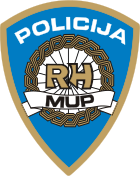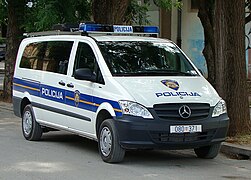Law enforcement in Croatia
| Police Policija | |
|---|---|
 Emblem of Policija | |
| Agency overview | |
| Formed | 1990 |
| Preceding agency | |
| Employees | 25,670 of which 20,870 are uniformed personnel |
| Annual budget | 4.48 billion HRK (EUR ~600 million or USD ~679 million)[1] |
| Jurisdictional structure | |
| National agency | HR |
| Operations jurisdiction | HR |
| Governing body | Ministry of the Interior |
| General nature | |
| Operational structure | |
| Headquarters | Zagreb, Ulica grada Vukovara 33 |
| Minister responsible | |
| Agency executive |
|
| Police Administrations | 20 |
| Facilities | |
| Airbases | Lučko (LDZL) |
| Helicopters | 9 |
| Website | |
| www | |
Law enforcement in Croatia is the responsibility of the Croatian Police (Template:Lang-hr), which is a public service of the Ministry of the Interior of the Republic of Croatia, carrying out certain tasks, the so-called, police activities, laid down by law.[2]
The Police deals with the following affairs: protection of individual life, rights, security and integrity, protection of property, prevention and detection of criminal offences, misdemeanors, violations, search for perpetrators of criminal offences, misdemeanors, violations and their bringing before competent authorities, control and management of road traffic, conducting affairs with aliens, control and security of state border, and other affairs defined by law.[3]
In the operative sense, police affairs are divided into affairs related to public peace and order, affairs related to security of public gatherings, affairs of the border police, affairs of safety of road traffic, affairs of counter-explosive protection, affairs of the criminal police, crime-technical affairs, crime-files affairs, administrative affairs, nationality-related affairs, status questions and asylum, affairs of protection and rescue, inspection affairs and technical affairs.[3]
In recent years, the force has been undergoing a reform with assistance from international agencies, including the Organization for Security and Co-operation in Europe since OSCE Mission to Croatia began there on 18 April 1996, with Croatia being admitted to OSCE on March 24, 1992.[4]
Police powers
Police officers' powers in order to maintain peace in Croatia, such as the power to stop and search, seize property and use force, are regulated.[5] A police officer in Croatia may only stop and search a person if a court has issued a warrant and it is possible that this person has broken the law or is in possession of items or tools which are considered unlawful.[citation needed]
A police officer is only allowed to use firearms if there is an immediate threat to his own life or the lives of other people, to prevent a crime from being committed for which the minimum prison sentence is five years or more, or to prevent the escape of a prisoner caught committing an offence for which the prison sentence is a maximum of ten years.[5]
Organization
The General Police Directorate (Template:Lang-hr) is an administrative organization of the Ministry of the Interior constituted for conducting police affairs. The General Police Directorate is responsible for:[2]
- screening and analysis of the state of security and developments leading to the emergence and development of crime;
- harmonization, guidance and supervision over the work of Police Directorates and Police Administrations;
- immediate participation in particular more complex operations of Police Directorates and Police Administrations;
- providing for the implementation of the international agreements on police cooperation and other international acts under the competence of the General Police Directorate;
- organizing and conducting of criminal forensics operations;
- setting the prerequisites for the efficient work of the Police Academy;
- adopting of standards for the equipment and technical means;
- setting the prerequisites for the police readiness to act in the state of emergency.
General Police Directorate is headed by General Police Director (Template:Lang-hr).
There are the following organization forms within General Police Directorate:[6][7]
- Police Directorate (Uprava policije)
- Criminal Police Directorate (Uprava kriminalističke policije)
- Border Police Directorate (Uprava za granicu)
- Command of Special Police (Zapovjedništvo specijalne policije)
- Operational Communication Centre (Operativno–komunikacijski centar policije)
- Forensic Centre (Centar za kriminalistička vještačenja)
- Police Academy (Policijska akademija)
- Special Security Affairs Directorate (Uprava za posebne poslove sigurnosti)
For immediate conducting of police affairs there are 20 Police Administrations (policijske uprave) divided into four categories, which cover the territory of the Republic of Croatia according to the organization of units of local self-government (counties or županije).
Police stations are established for direct police and other affairs in each Police Administration.
Border control
Croatia has had an external border with the Schengen area since the accession of the country to the EU. As part of the major migration movements from 2015, Croatia became part of the so-called Balkan route. The European Border Agency Frontex has a small mission in Croatia to assist the police at various border crossings. In July 2018 Frontex organized the air reconnaissance of the border with Bosnia with a reconnaissance aircraft as part of the Frontex 'Multipurpose Aerial Surveillance (MAS). The aircraft transmit moving images of remote sensing cameras in real time to the Frontex Situation Center (FSC) in Warszawa.[8]
Critics
For several times NGOs report, that the Croatian police illegally and arbitrarily deport refugees to Bosnia-Herzegovina, ie from the EU (push-backs). It would come again and again to attacks by the Croatian officials to the refugees.[9][10][11]
Ranks
Regular Police (Temeljna policija)
Intervention Police (Interventna policija)

Special Police (Specijalna policija)

Weapons
- MP5
- UZI Uses Copy of the Mini-Uzi variant manufactured as Mini ERO [12]
- G36C
- CZ75
- HS2000
- H&K UMP
- H&K MP7
- H&K 417
Equipment
Since 2013, there were special efforts by the Ministry of the Interior to equip the Croatian police with new vehicles and uniforms. Police cars consist mainly of Opel Astra 4-doors, some Citroën C-elysée and, more prominently, Ford Focuses (unmarked sedans and marked estates).
-
Croatian Police car
-
A motor officer patrolling in Zagreb on a motorcycle
-
Water cannon model CVT-6000
-
Police van
-
Police boat Cantiere Navale Vittoria V-800HR
Helicopters
| Aircraft | Quantity | Introduced | Notes |
|---|---|---|---|
| Agusta-Bell 212 | 1 | 9A-HBM | |
| Bell 206B | 3 | 9A-HDB, 9A-HBZ, 9A-HBC | |
| AgustaWestland AW139 | 2 | January 2016 | 9A-HRP,9A-HPH, second delivered on 28. June 2016.[13] |
| Eurocopter EC135 P2+ | 2 | 2013 | 9A-HBA, 9A-HBB, [13] |
| Robinson R22 Beta | 1 | 9A-HAG, [citation needed] |
See also
Notes
- ^ https://www.mup.hr/public/documents/Financijska%20izvje%C5%A1%C4%87a/Financijski%20plan%20Ministarstva%20unutarnjih%20poslova%20za%202018.g.%20i%20projekcije%20za%20%202019.%20i%202020.%20godinu.pdf
- ^ a b Police
- ^ a b Republic of Croatia, Interpol
- ^ OSCE Mission to Croatia retrieved from here on May 19, 2007
- ^ a b Police, Croatia retrieved from here on May 19, 2007
- ^ Organizational scheme of General Police Directorate
- ^ Ministarstvo unutarnjih poslova
- ^ https://www.euronews.com/2018/11/30/frontex-caught-people-smugglers-in-croatia
- ^ https://www.dw.com/en/croatia-police-accused-of-abusing-refugees/a-45110455
- ^ https://www.zdf.de/nachrichten/heute/menschenrechtler-kroatien-schiebt-migranten-ab-100.html
- ^ https://www.welt.de/vermischtes/article176846099/Kroatien-Polizei-schiesst-auf-Kleinbus-mit-illegalen-Migranten.html
- ^ "Archived copy". Archived from the original on 2009-10-01. Retrieved 2009-10-22.
{{cite web}}: CS1 maint: archived copy as title (link) - ^ a b c d e AirForces Monthly. Stamford, Lincolnshire, England: Key Publishing Ltd. March 2016. p. 10.
{{cite book}}: CS1 maint: year (link)

























![Agusta-Bell 212[13]](http://upload.wikimedia.org/wikipedia/commons/thumb/d/d5/Croatian_police_Augusta_Bell_212.jpg/297px-Croatian_police_Augusta_Bell_212.jpg)
![Bell 206B-3 JetRanger III[13]](http://upload.wikimedia.org/wikipedia/commons/thumb/3/32/Croatian_police_helicopter_Bell_206_B.jpg/224px-Croatian_police_helicopter_Bell_206_B.jpg)
![Bell 206B JetRanger II[13]](http://upload.wikimedia.org/wikipedia/commons/thumb/3/32/Croatian_Police_Helicopter.jpg/240px-Croatian_Police_Helicopter.jpg)